by Steve Graham
Cable. Is there a more unloved audio component? I think I’m with the majority that finds them a necessary evil. I mean, how can any sane person get excited by mere wire? Except perhaps the people selling them. Once you’ve closed a deal on say, a new pair of speakers, that likely have a low profit margin, you will be encouraged to enhance their performance with a new set of cables. Cables that likely have a fairly high margin. No, I’m not advocating hardware store wire for speaker connection or cheap, no-name interconnects. Later in this review I’ll expand on a strategy for trying a new cable when purchasing a component.
I’m writing this in mid-April 2020. The world is in the grip of the COVID-19 pandemic. Perhaps I’m in the minority that finds music listening and audio gear a bit frivolous. With the threat of disease and the resultant social upheaval, one feels almost guilty enjoying music, food, wine and all the other things that makes us human. Enjoyment seems a bit trivial when health care workers and all of the others that serve us continue to risk their wellbeing for us. People are on edge, myself included. A week or so ago I snapped at a stranger that wanted to engage me in a conversation. The poor sad old bugger might have been feeling some social isolation. I told him clearly and succinctly that being at a medical clinic was not a social occasion. In any event, for this review I had to force myself to turn on my music system and suspend the anxiety life has become lately. Does enjoying myself while others are suffering make me a bad person? I hope not.
A Little Digital History
It was almost 40 years ago, 1982 to be precise, that the compact disc format was launched with the best technology the late 1970s had to offer. I read somewhere that the digital format used to encode music on the compact disc is more or less music buried in a clock signal. It’s well know that timing errors, usually described as jitter, are the Achilles heel of digital audio. The precision of the timing – the synchronization, for lack of a better word – between the clock and the music data recovered during playback, is a significant driver of the quality of the analogue signal we eventually hear.
My digital history started in 1984 with a second-generation Yamaha CD player. Another couple of CD players later and I was ready for digital separates. One CD transport and four D-to-A converters later, I returned to a CD player, a then top-of-the line Cambridge. The Cambridge served me well for about 10 years, but its drawer was getting creaky and it wouldn’t always load and read discs.
Digital Today
In the autumn of 2018, I took what was for me a huge plunge into the world of file-based playback with the purchase of a NAD M50.2 digital music player (see my review). The 50.2 doesn’t have a D to A converter. My long-in-the-tooth Cambridge CD player had digital inputs, so as a stop-gap measure it did the decoding via a 75-ohm data link.
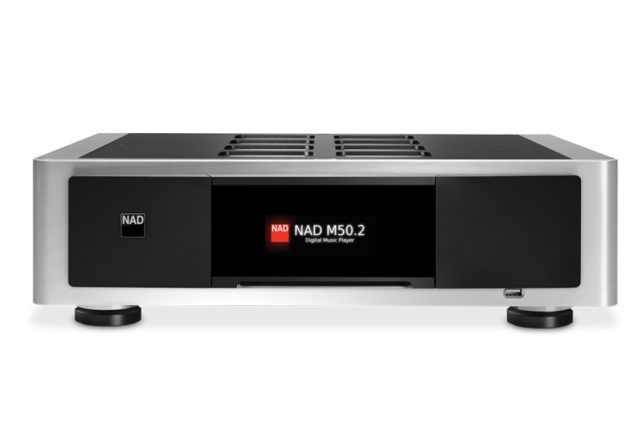
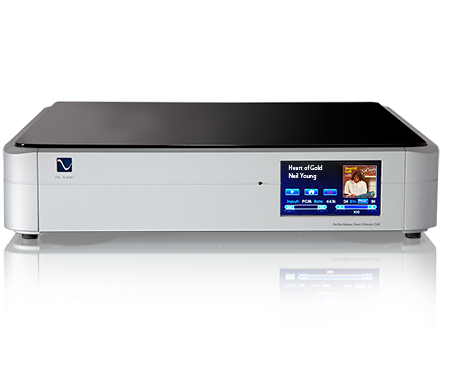
With the acquisition of a PS Audio DirectStream DAC in late 2018 (purchased earlier than planned, it was on sale) my digital “front end”, was up to date, almost. As the M50.2 has a balanced AES/EBU output and the DirectStream an AES/EBU input, a homemade balanced digital interconnect, resurrected from a decade or so earlier, was pressed into service. Made with a pair of Neutrik plugs and a piece of van den Hul 110-ohm cable, it had served to connect an Audio Alchemy jitter reduction device to a couple of generations of 20-bit DACs in the late 1990s and early 2000s.
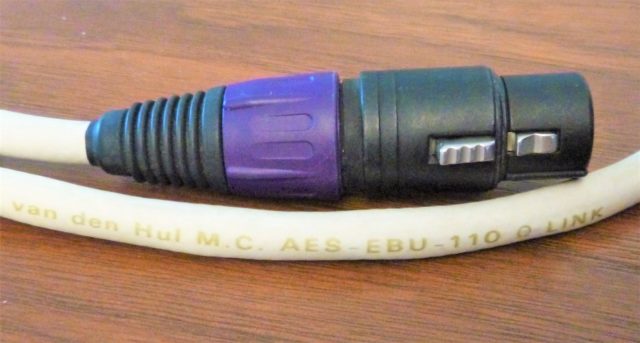
Time and technology move on, so it was time to take the plunge on a new digital data link. Call me cheap (ish), call me misguided, but I wasn’t about to take the plunge of many multiple hundreds of dollars on a piece of wire. For about $250 Canadian (~$180 US) I could just about justify a punt on an Audioquest Carbon AES/EBU cable. The Carbon is second in a line of six AES/EBU cables from Audioquest.
A Matter of Impedance
This will be a gross over-simplification, so experts, please no nasty emails. Impedance is to AC what resistance is to DC, sort of. With analogue audio signals, impedance, for the most part, isn’t such a big deal. Generally, we want source components, be they preamps, amps or phono cartridges to have low output impedances. We want the inputs of preamps, amps and speakers to have high, or at least higher than the components driving them, input impedances. It just works better that way.
In the world of RF (radio frequencies), which is what digital signals are more or less running at, signals are transferred more cleanly when all impedances match. i.e. 110-ohm output impedance, 110-ohm cable, 110-ohm input impedance. Even the connectors, be they the jacks on the components or the plugs on the interconnect cable should be 110-ohm impedance (or 75-ohm in the case of non-balanced digital interconnects).
Timing is Everything
When impedances don’t match, the signal can interfere with itself resulting in timing errors (jitter). A jittered signal is a corrupted signal. Corrupted will not be true to the intended analogue waveform. The culprit for some of this jitter sensitivity can, in part, be traced back to the consumer digital standard. The consumer standard bundles the music and timing information down the same piece of wire. Many professional (and some ultra-exotic consumer components) transfer the clock signal and data signals separately thus potentially lowering jitter. Where does all of this leave us? We are still some way off from “Perfect Sound Forever”.
Optimizing the transmission and reception of digital signals means considering the interconnect too. By matching all of these elements, we stand a better chance of recovering the analogue signal with as much fidelity to the original as possible. By no means is the connection between digital source and D to A converter the only source of jitter. During A to D conversion and at all points along the digital pathway on the recording side, timing errors can creep in. It also takes superior engineering and implementation within a D to A converter to keep timing errors in check. But the interconnection of our stereo components is something audiophiles can optimize.
YMMV
The other thing I must mention, and the reason many reviewers don’t do cable reviews, is that the components connected can have a significant impact on audible results. The YMMV qualifier was never more relevant. Take this as one person’s personal journey not necessarily a road map for all to follow.
System Context:
NAD M50.2 digital source
PS Audio DirectStream DAC with latest software
Audio Research Corp. Reference 3 Line Stage
Audio Research Corp. Reference 110 Power Amp
Spendor D9 Speakers
PS Audio Power Regenerator
Various Cardas and Kimber analogue interconnects
Space, The Final Frontier
I find that in the absence of absolutes and meaningful measurements, comparison is the only way to evaluate most audio components. With that in mind I compared the Audioquest to my homemade cable. At first the differences seemed non-existent. But after a couple of hours, I find this often happens, something just caught my ear and from then on, the difference between the two was obvious. Perhaps my system was just finding its groove after an extended period of down-time.
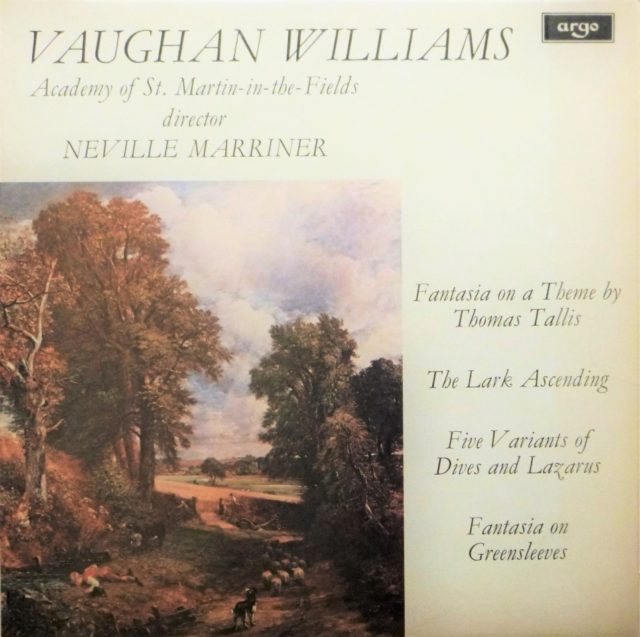
I digitized this Vaughan Williams album, using my Project ‘table with Ortofon Quintet Bronze cart. A K&K SUT connected the cart to my prototype Tubecad Tetra phono amp. Digitization was performed by a Schiit JIL A to D converter.
It astonishes me the level of information retrieval and just plain musical enjoyment that dragging a rock though a wiggly ditch formed in petro-chemicals can yield.
Repeated playings of the Tallis Fantasia while switching back and forth clued me in to the differences between two cables.

Once heard, the differences were also obvious with the Sting & Shaggy album, streamed in MQA.
And the difference? Space. The illusion of recorded space. With the home-brew cable, there seemed to be a centre image with some instruments stuck to the speakers in a more or less flat-ish plane. With the AQ Carbon there was a continuum of images between the two speakers, as well as greater depth to the audio event as well. This was more obvious with the Vaughan Williams, but once heard, all tracks played exhibited this trait to varying degrees. Other tracks included Miles Davis and Sir Rosevelt, both streamed in MQA. Some 44/16 Mark Knopfler and Ella Fitzgerald from my personal library rounded out the audition tracks.
The reason? Who knows? The NAD M50.2 is known to output a clean digital signal. PS Audio goes to heroic lengths to reduce the effects of jitter in the DAC. My belief is that jitter, or whatever is causing a degradation of signal integrity, interferes with the miniscule but important timing information that our ears and brain use to locate the position of instruments or voices within the construct we call an “audio image”. I could be completely wrong about the reason, but I’m in no doubt as to the resultant improvement.
Now that the dust has settled, I’m glad I purchased the Audioquest Carbon digital interconnect. What does this mean for you? Not that much really. I have little trouble recommending certain speakers and amplifiers I’ve reviewed. As mentioned previously, interconnects can be very system dependant. My only recommendation is that before laying down any long green on a digital component, you make contingent on purchase the loan of, and return if desired, an interconnect or two. You have the whip hand, as the saying goes. If the seller balks just remind them of the golden rule of sales: The person with the gold makes the rules. Don’t expect differences to be of the slap-in-the-face variety. Be sure to burn them in – I put about five weeks worth of running on the AQ – before forming any judgements.
In Conclusion
The best 250 bucks I’ve spent on system hardware in a long time. Am I going in search of a more upscale digital interconnect? Not anytime soon. Tubes are calling, see below.
Audioquest Carbon AES/EBU Balanced
Selling price: around $289 CAD (1 meter)
Source of review: reviewer purchase
A Question of Balance
Balanced versus unbalanced connection. Balanced connections, typified by XLR-type connectors have three pins. Two pins carry the signal on a typically twisted pair of wires. The third pin, typically connected to a shield, is ground. Neither of the two signal-carrying wires are connected to ground.
Unbalanced, typically RCA-style plugs and jacks (BNC types are sometimes used for digital signals) carry the signal on a centre conductor and the shield that surrounds it. This means that the signal is also carried on the ground where it is more susceptible to interference.
In the professional world, balanced connections are used almost exclusively. Everything from microphones through to recorders, this to lessen the chance of interference and ground loops. It also facilitates longer cable runs too.
Both the RCA-type and balanced digital connections transmit the same data. The voltages and impedances are different though.
I’d planned to engage Miss K to model for this review. Alas, social distancing is the order of the day. I’ll endeavour to get her back for another review or two when appropriate.
Speaking of reviews, another WOS.ca writer has a treasure trove of vintage gear. There’s a preamp in need of repair and a Leak power amp that’s just crying out for some rehabilitation. I hope to write these up under the CHE (Classic/Heritage/Exotic) banner later this year.

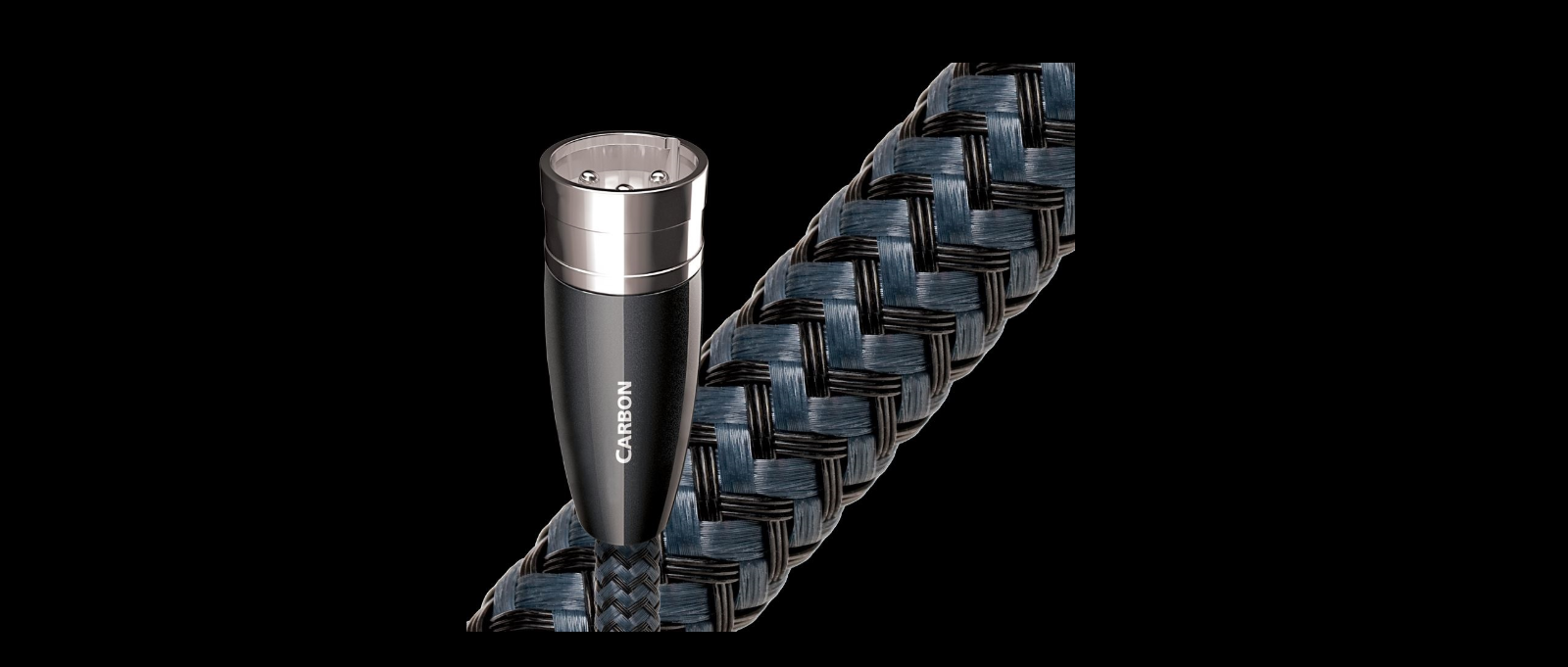
The people suffering or working on the front lines do not wish for those who are well to be suffering with them. They’d wish for them to isolate/social distance to the greatest extent possible, donate to causes where means permits, try their best be particularly kind where there is a need to interact with others – but to otherwise find enjoyment in their lives while they have them to the fullest extent possible. That’s the whole point and the reason why they are working hard.
So… enjoy that AES/EBU cable!!!
Hey Steve: Good article/read. In the 40-years I’ve been (actively) involved in the hi-fi business, I don’t know of ONE person who does/says this (when the objective is quality music reproduction): “Oh-yeh, let’s plop down $200/$2K (or more) on some cable/wire as if it were a similar bet/game laid down in Casino’s”
NOBODY (particularly me) likes e thought of spending hundreds-of-dollars (sometimes thousands) on anything unless it has a profound impact on SQ – commensurate with price/cost of.
And, it’s wise to ‘hear this’ (a cable’s impact) on multiple occasions, before we make the commitment/purchase. And most folk/hi-fi guys I know, are careful like this. Over time, both a personal and collective consensus is established -and we make the ‘jump’.
If you haven’t already, I’d strongly recommend to consider an AC-Regen. (For Digital Only (i.e. low power/300-500 watt model) or a nice/clean Balanced/ Symmetrical AC power supply -for ALL hi-fo components; one for Analog Amp/Pre -the other Bal/Symm. unit for Source/Digital components.
The first time I heard Digital powered by an AC Regen (PS Audio P-300, circa 2001?), it was jaw-dropping impressive -also stated by customers who heard / borrowed it for evaluation. Everyone commented on its remarkably positive contribution/improvement to CD/DAC SQ.
If one’s love for music is enhanced by such products (its been known to !), it’s a smart/satisfying investment indeed.
peter jasz
Since hi-res digital recording is a decent part of my life, quality cabling is as well.
Nothing is going to perform better than Mogami cables. The reason they are the studio standard is not only their performance, but the rugged construction. No engineer is going use anything, but the best for wiring up a $8K microphone.
And no one spends $20M on a studio and then cheaps out on the cabling.
In fact, due to the shear length & number of the cable runs and the fact that there is so great an opportunity for cables to both induce and receive EMI noise, proper design is paramount. There is nothing magical about cable design regardless of what “hi-fi” cable manufacturers claim. It’s science that’s been well known for a half century.
Here’s a thought: buy a Mogami AES cable and compare it to what you have just reviewed. A 3ft. Mogami AES cable runs about $55. A 50ft. runs about $150. Go one step further and have a friend place one of the cables in your system one day and then swap it out the next. Do that a few times and see if you can hear any difference.
I bet you can’t.
Mogami makes many different cables at different levels of cost and performance (including OEM for hifi companies). Doesn’t that nullify your theory?
Who wrote this 1-5 BS ?
Do you have a name ?
pj
Your argument assumes a few things that are simply not based in reality.
First, no one spends $20 million on a recording studio(anymore). There are a few amazing recording studios left, but most of them are hardly worthy of the name when compared to some of the truly wonderful ones that used to exist.
Secondly, I worked at a few of these studios back in the late 1980s(Oceanway and Record One, amongst others), and I travelled around to lots of others. Studio owners were for the most part in constant state of anxiety about their financial situations which was hardly surprising since most studios did not-even then, when record labels actually offered up significant recording budgets to artists-really run a profit. A few owners actually made their money by purchasing the equipment from bankrupt studios and reselling that equipment(cough-Allen Sides-cough).
Thirdly, and particularly one point, you are either deluded or in denial about the great many areas where recording studio owners attempted(and still attempt) to save a buck. Mogami is popular in SOME recording studios(most use cheaper cables), but arguing that it is the best is rather like claiming the US is the best country in the world; it is empty rhetoric based on wishful thinking. The most important qualities for mic cables if you are running a business are that they are quiet, durable, and affordable.
Professional audio equipment is primarily designed for ease-of-use, durability, and sound quality; in that order I would argue. George Massenburg made probably the most transparent audio compressor the audio world has ever seen. I imagine that less than one percent of all studio engineers have even seen one, much less know how to operate it to get the best results(and yes, it’s not as simple as most[it’s not really harder to use, but you have to think]).
So spare us the asinine hyperbole about how “recording engineers use only the best”. It’s as trite and as inaccurate as “farmers are the real environmentalists”. Recording engineers do their best with what they have. Either listen to other products and offer up an informed opinion, or don’t. But don’t pontificate on the basis of an appeal to authority that is disingenuous and uninformed.
Cheers,
Alan Tomlinson
who happily no longer toils in the recording industry that died years ago
To all that have taken the time to comment, thank you. I remain somewhat agnostic on the topic of expensive cables though I am convinced of the need for purpose-built cabling for digital interconnection. I suspect the need for impedance matching in the digital domain is necessary right down to the connectors themselves, XLR-type in the reviewed cable. Perhaps the generic XLRs on my old digital cable were its undoing.
I’m less convinced that strict impedance matching is necessary for analog connection. I was going to detail the DIY interconnects in my analog signal path but I think I’ll hold off on that for the time being.
Mr. Henning, Mogami cable is also a favourite of Richard Murdey of RJM audio whose phono preamp I’ve reviewed for WOS.ca. http://phonoclone.com/int-mog.html So Mr. Henning, here’s my proposition: suppose I build you a set of analog interconnects, XLR or RCA terminated, your choice of length but my choice of cable and terminations. You would pay for them (less than $100), I’d write up the process for a WOS DIY article and you could write a review of their sound quality. In fact, if you’d like to send me a piece of your favourite Mogami I’ll make you two sets of interconnects. One set with the Mogami and a set with my favourite cable.
Thank you for your interest in Wall of Sound.ca
Regards, Steve
Touche’, Alan !
peter jasz
Mr. Henning: It’s clear to see you have considerable experience when you say:
” …Nothing is going to perform better than Mogami cables.”
For sure. And nothing beats the utility (heck performance) of a VW ‘Bug’.
pj
Steve: Don’t waste your time (RE: Cable comparison).
pj
1)
An AES cable shouldn’t impart any coloration or have the slightest sound signature. If it does, it’s demonstratibly flawed, and the engineer should hurry back to the drawing table.
2) XLR plugs are not impedence rated and can be used for both analog and digital cables. They may aquire some corrosion over time, but removal and re-insertion will remedy that.
3) Mogami is an excellent brand, but there are other cable manufacturers with equally good products that are widely used: Canare, Gotham and Belden,for example. Those are proven cables , with published measurements, that imparts no sound to the transmitted signal whatsoever.
4) The facts that some of these companies have multiple AES products doesn’t nullify a thing
Each product line has a different, and clearly stated, purpose: Either for longer runs, or for extra bending.
5) Audioquesst makes beautiful products that give a final touch to one’s rack. Thier standards are pretty high too. However, don’t expect any sound quality improvement. First, there’s no working theory why they should make a difference; second, the fact the company omits publishing measurements and conducting double blind tests should tell you everything about their actual efficacy.